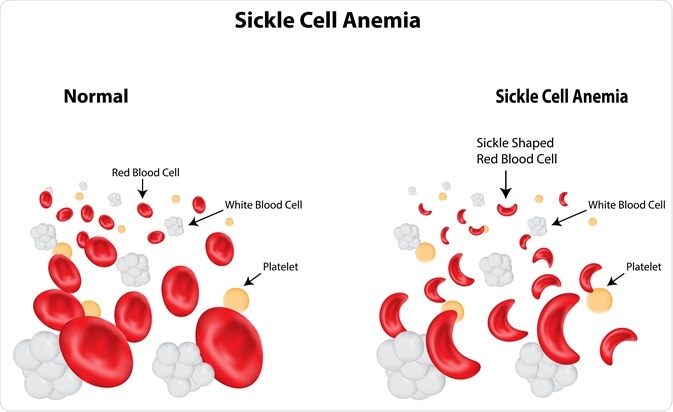The diagnosis of sickle cell disease usually involves a blood test that is analyzed for defective genes or hemoglobin cells. There are also several screening programs to promote an early diagnosis of the disease, including prenatal and antenatal screening.
As sickle cell disease is an inherited genetic condition, it is essential that a complete family medical history be gathered. In particular, both parents must be carriers of the disease for the child to be affected by sickle cell disease.
 Normal blood cells and blood cells in sickle cell anemia. Image Credit: joshya / Shutterstock.com
Normal blood cells and blood cells in sickle cell anemia. Image Credit: joshya / Shutterstock.com
Blood test diagnosis
Sickle cell disease can be diagnosed with a blood test, which is analyzed with haemoglobin electrophoresis and other techniques to determine if the defective type of hemoglobin is present in the blood. A trace amount of defective hemoglobin in the blood sample suggests that the individual carries the genetic trait, whereas a high level represents the presence of sickle cell disease.
Newborn screening
All babies born in most developed countries are currently offered screening for sickle cell disease, shortly following the birth. This is offered as a component of the newborn blood spot test, which is also sometimes referred to as the heel prick test. If the test is found to be positive, a second test should be done to confirm the diagnosis.
An early diagnosis is beneficial, as it can help to prevent complications that may arise as a result of the disease and hence improve the prognosis of the patient.
Screening for pregnant women
Pregnant women may be offered screening tests that checks for the presence of gene defects that may lead to sickle cell disease in the baby.
This is used most frequently used in regions where populations are at the greatest risk of genetic diseases related to hemoglobin. Women living in low prevalence areas may be asked to answer a questionnaire about the family origins that helps to determine the risk of the baby being affected by the condition. Further investigations are then made for women and babies at high risk.
If a pregnant woman’s test is found to be positive, their partner usually needs to be tested for the presence of sickle cell train. If both parents carry the gene mutation, any children will have 25% risk of suffering from sickle cell disease.
A prenatal diagnosis of the baby can be made using an amniotic fluid or placenta tissue sample, which can be tested for genetic abnormalities. This can be practiced as early as two months after conceiving.
Sickle Cell Anemia: A Patient's Journey
Pre-implantation genetic diagnosis
When both parents are aware that they are carriers of the sickle cell disease gene and prefer not to have a child with sick cell disease, they can opt for pre-implantation genetic diagnosis (PIGD) to manipulate the fertilization process.
This is similar to in vitro fertilization (IVF) and involves the removal of eggs from a woman’s ovaries and fertilization in a laboratory setting. The embryo can then be tested for sickle cell anemia and implanted into the woman’s womb only if the results are negative. It is a relatively new procedure and can be costly to be carried out.
References
Further Reading